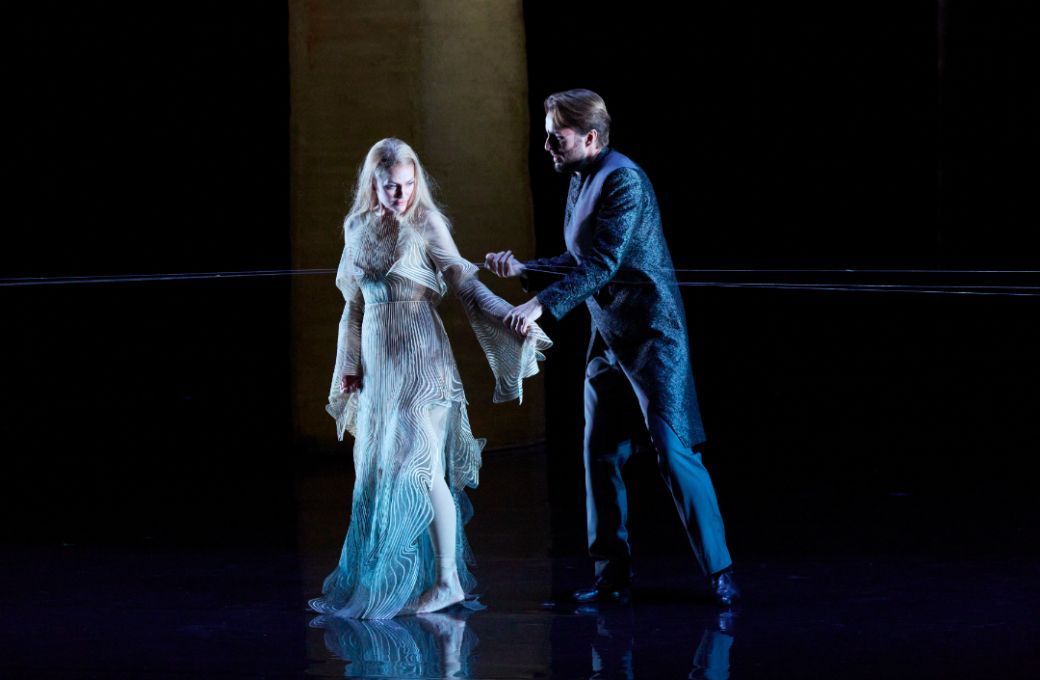The curtain rises on a stage sunk into darkness, at its heart a delicate spinning galaxy. Below, a spiky knot of dancers writhes. In a world of fog-enshrined forests and dangerous seaside grottoes, our heroine appears: Mélisande, blonde hair cascading down her shoulders, clad in gold, about to meet her future husband Golaud, who is on a hunt.

This is the Grand Théâtre de Genève’s Pelléas et Mélisande, as imagined by Damien Jalet, Sidi Larbi Cherkaoui and Marina Abramović: a revival of the 2021 pandemic-era streamed production, given a second chance to shine. And shine the production certainly does, nonstop. A staging by two choreographers and a performance artist is never going to be dull, though at times the aesthetic runs the risk of overwhelming the music.
The scenography is not subtle. At its heart, it draws on the symbolist keystones of Maeterlinck’s libretto, adapted from his own 1893 play: pure light and pure dark, innocence and loss. In reality, it sometimes ends up a little clunky, with the characters hobbled by their high-fashion outfits and Abramović’s giant plastic crystals littering the stage like playground equipment. But there is much to enjoy here, among the maximalism, especially if you’re willing to take the opera at more than face value.
The story is not quite as simple as it seems, a kind of profound melancholy infecting the edges of the old medieval tale of forbidden love. The palace is a place of closed doors, unspoken melancholy. The kingdom of Allemonde is struggling with famine. The beginning and end of Mélisande’s story are full of unanswered questions. And Debussy’s restrained writing for the voice is full of discreet treasures.
Mari Eriksmoen played Mélisande as otherworldly in her innocence, her voice liquid and clear, shading into girlishness. The audience went completely still for her goosebump-inducing unaccompanied folksong. She was well matched by Björn Bürger, a newcomer to this production, who brought a winning earnestness to Pelléas. Both did their best with Maeterlinck’s expository libretto, playing the characters completely straight, as innocents – sleepwalkers, to use Antonin Artaud’s term – caught in the grip of inescapable forces driving them towards an inexorable end.
Bringing these metaphorical forces to physical life, seven dancers chosen from the Eastman Dance Company and the Grand Théâtre ballet troupe, pure muscle and menace, move as one, almost silently, across the black stage. At several points, they spin a cat’s cradle of shining ropes binding the characters to one another, a metaphor that quickly transcends any risk of obviousness by force of sheer technical skill. When the dancers are onstage, it’s quite hard to look away. I’m still undecided as to whether this is a good thing for the production.
Admittedly, Debussy’s vocal score is not designed for soloists to show off. No virtuosic melodic leaps, no feats of Wagnerian power, no hummable arias: the composer wanted to create something more subtle, to move away from overtly dramatic operatic traditions, to write “antilyrical” lines that wouldn’t get in the characters’ way. Furthermore, to contrast with the busy stage and constant movement from the dancers, the soloists are largely static.
Leigh Melrose’s spellbinding performance as Golaud was the exception to this rule, an ambiguous character among childish ones, tortured, doubting, resisting his own worst instincts until cruelty and bitterness overcome him. His elegant, complex baritone sketched in additional depths to his character that the central pair simply didn’t get to show. There were some great voices among the secondary characters too, most striking of them all Nicolas Testé as Arkel, whose rich, dark tones filled the stage, radiating kindness in an ambiguous world. Charlotte Bozzi, meanwhile, was excellent as Yniold, Golaud’s son – a winning presence and an elegant timbre, with just a little more shading than a boy soprano could give the role.
Playing for the first time under Juraj Valčuha’s baton, the Orchestre de la Suisse Romande brought Debussy’s delicate, shimmering score to life with sensitivity and grace. The orchestral interludes sounded particularly wonderful. I wondered afterwards if this was simply because in these moments, the curtain fell, and some of the visual noise dropped away. Overall, I walked away from the Grand Théâtre feeling conflicted: there is much to admire, here – perhaps too much. Enough is as good as a feast.


